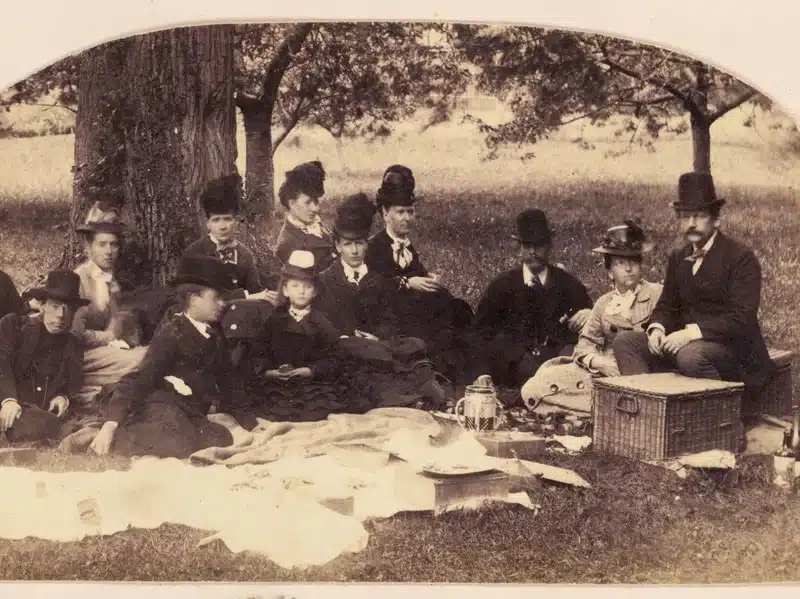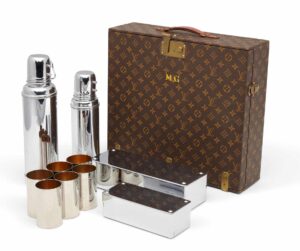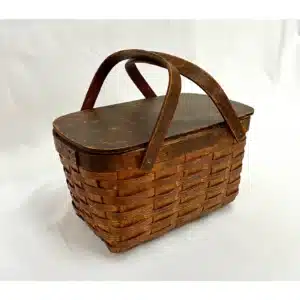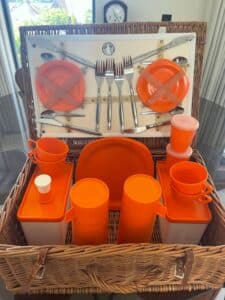Vintage Picnic Sets: A Nostalgic Feast in a Basket
By Jessica Kosinski


When talking about summer fun, there are certain activities that instantly come to mind: swimming, camping, biking, and more. In between those sun-soaked adventures, everyone has to eat – and few things feel more quintessentially summer than a picnic. Whether held at a park, on a beach, or right in your own backyard, the picnic has long been a treasured tradition. In fact, it’s become so beloved that collecting vintage picnic sets has grown into a popular hobby. Let’s take a look at the history and enduring appeal of these charming sets.
Pic•nic
The first literary mention of anything resembling the word “picnic” appeared in a 17th-century French poem about a gluttonous character named Pique-Nique. The term soon came to describe informal indoor gatherings where guests brought food and drink – what we might now call a potluck. In 1801, the “Pic-Nic Society” emerged in London, hosting nights of indulgence filled with music, gambling, and revelry until disbanding in 1850. The word lingered, eventually morphing into “picnic” and migrating outdoors.
By the 18th and 19th centuries, the nature of picnicking had evolved. Urban dwellers, seeking respite from crowded cities, headed into the countryside for fresh air and elegant outdoor dining. These escapes often featured lavish spreads, complete with multiple courses and libations like champagne. Merchants took notice, selling specialized “hampers” – early picnic baskets designed to carry dining ware and delicacies in style.
To the 20th Century

Around the turn of the 20th century, more sophisticated picnic sets began to appear. These were often made from wicker or leather, with compartments for cutlery, glasses, napkins, and plates. Some were crafted purely for luxury – Louis Vuitton, for example, produced elegant versions fit for high society. Others catered to the middle class, offering functionality and style. The Peterboro Basket Company, founded in 1854 and still operating in New Hampshire today, became a staple for hand-woven baskets in New England.
The automobile boom of the early 1900s made it easier for families to explore nature beyond city limits, fueling a surge in portable picnic gear. By the 1950s, manufacturers such as the U.K.’s Brexton created compact aluminum picnic sets in bright colors, often commemorating special events – like the 1953 coronation of Queen Elizabeth II. These sets typically included matching thermoses, plates, and utensils, all neatly housed in cases tailored for car travel.
The Mid-Century Shift
The 1970s brought a shift in picnicking culture. Plastic became the material of choice, with brands like Tupperware offering lightweight, easy-to-clean components. Gone were the elaborate spreads of lobster and roast meats – in their place came sandwiches, hot dogs, and deviled eggs. Picnicking became more casual, more accessible, and more reflective of the average family’s lifestyle.
Vintage picnic sets vary not just by material but by size. Early sets were designed for couples, but by the 1930s, four-person sets gained popularity, followed by larger options for six or eight. These sets reflect evolving social habits, from intimate dates to large family outings.
Variety!

Collectors today will find a delightful array of styles and materials. Wicker baskets – woven from willow or rattan – remain a timeless classic, equally perfect for use or décor. Metal baskets, popular in the 1940s and ’50s, often feature cheerful gingham prints or floral designs. Some baskets have sturdy wooden handles, while others –especially trunk-style family sets – were made handle-free for stacking and storage.
Food, too, has evolved with the picnic. In its early days, a picnic might include fine wine, cold meats, and pastries. By the mid-20th century, the menu had shifted to include fried chicken, potato salad, fruit, sandwiches, and pies – dishes chosen for their ease of transport and ability to be enjoyed at room temperature.
But a picnic is more than just a meal – it’s a shared experience. The act of dining al fresco fosters connection, whether among friends, families, or romantic partners. In the 19th and early 20th centuries, picnics even served as socially acceptable settings for courtship, providing a relaxed backdrop for budding romances.
Collecting This Trend-Setter
Why collect vintage picnic sets today? Some seek them out for functional use, enjoying the nostalgia of packing a mid-century basket for a modern-day outing. Others display them as part of home décor or seek specific brands, such as Brexton or Louis Vuitton. Complete sets in excellent condition are rarer and more valuable, but even partial sets offer historic charm. Just be sure to inspect for rust or cracks if you plan to use them.
Vintage picnic sets can be found at antique shops, flea markets, estate sales, and online. Prices range from affordable to extravagant depending on rarity, completeness, and condition. For some, the thrill of the hunt is half the fun – stumbling upon a 1950s aluminum set in a thrift store is a find worth celebrating.
Whether restored or repurposed, displayed or used, vintage picnic sets bring a sense of nostalgia and delight. Some collectors even refresh them with new linings or replacement pieces, blending old-world charm with modern convenience. A restored basket, after all, can be both a conversation piece and a functional keepsake.

Despite changes in lifestyle, transportation, and materials, the heart of picnicking remains unchanged. Gathering outdoors with food and friends is a tradition that transcends generations. Today’s picnic sets may boast eco-friendly materials or even built-in Bluetooth speakers, but the essence – good company, fresh air, and simple pleasure – remains timeless.
From 17th-century French salons to 1970s road trips, picnicking has delighted people across centuries and continents. Vintage picnic sets serve as tangible reminders of those joyful moments, each one a story waiting to be retold. So, whether you’re a collector, an occasional adventurer, or someone who simply loves a good sandwich on a sunny day, consider packing a vintage basket and heading outdoors. The world – and lunch – is waiting.
Jessica Kosinski has been a freelance researcher and writer since 2001. She developed a passion for pre-1990s television and films as a child and she has never grown out of it. Recently, she turned that passion into a retro TV and film blog. Follow along with her at https://medium.com/@jkos_writing, as she dives deep into the characters, actors, quirks, and trivia that brought us some of the greatest films and shows in TV history and also discusses some of the more obscure films and shows most of us may have forgotten.

